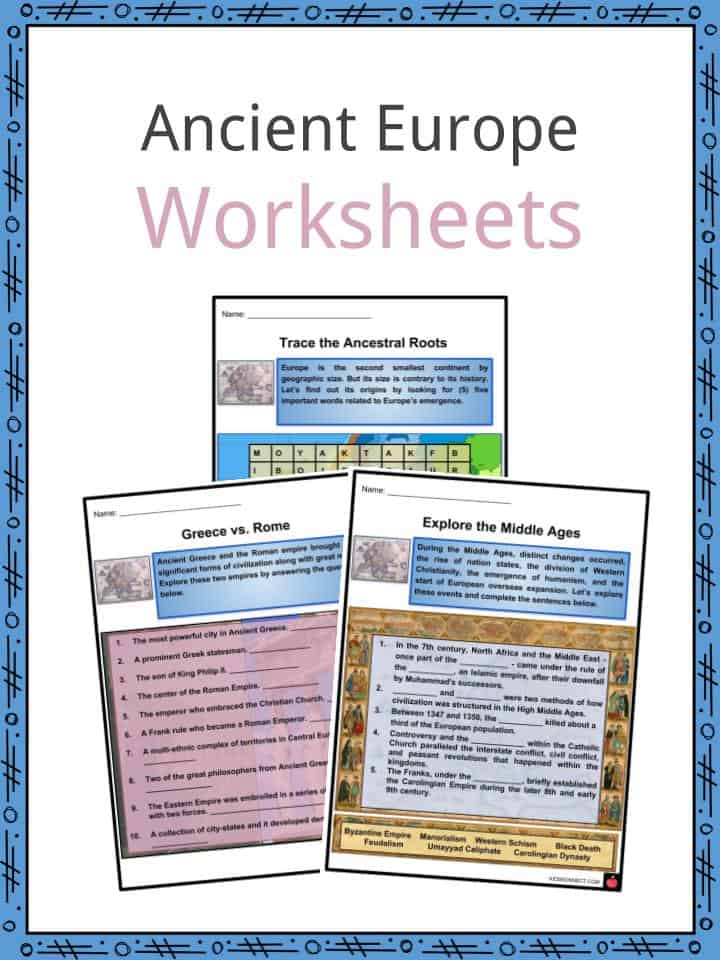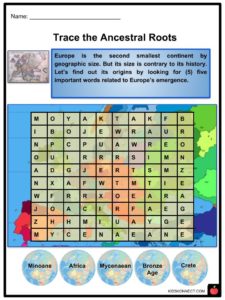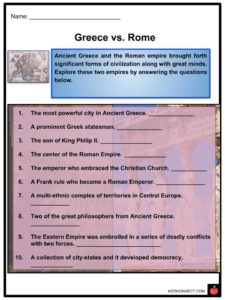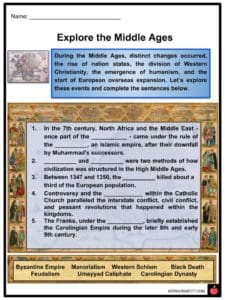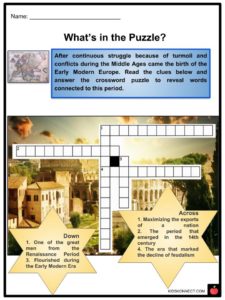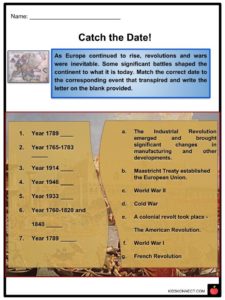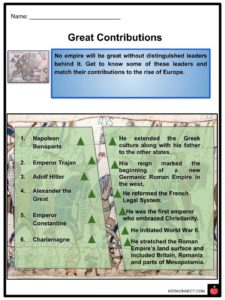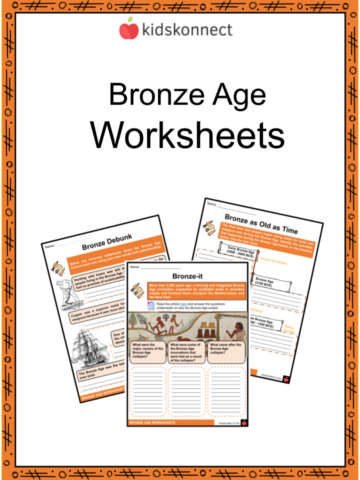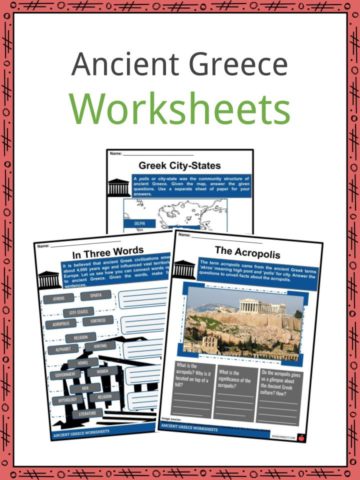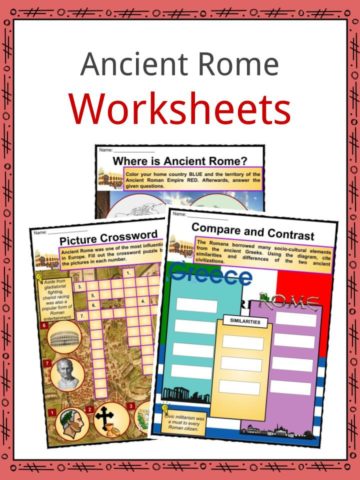Download This Sample
This sample is exclusively for KidsKonnect members!
To download this worksheet, click the button below to signup for free (it only takes a minute) and you'll be brought right back to this page to start the download!
Sign Me Up
Table of Contents
During the Neolithic era (beginning around 7000 BCE) and the Indo-European migrations (beginning around 4000 BCE), Europe experienced massive migrations from the east to the southeast, bringing agriculture, technological advances, and the Indo-European languages, mainly through the Balkan peninsula and the Black Sea region. The Minoan and Mycenaean civilizations flourished from the Bronze Age until they perished around 1200 BCE and were two of the best-known late ancient European cultures.
See the fact file below for more information on Ancient Europe, or you can download our 26-page Ancient Europe worksheet pack to utilize within the classroom or home environment.
Key Facts & Information
PREHISTORY OF EUROPE
- The discovery of modern humans in Europe – maybe as early as 55,000 BCE, but probably by 35,000 BCE – was followed by significant advances in society and technology.
- Following the last major Pleistocene glacier, there was a period of dramatic change that included the rapid adoption of farming and the creation of permanent towns beginning in the 7th millennium BCE. This established the groundwork for all subsequent advancements in European civilization.
PALEOLITHIC SETTLEMENT
- Homo erectus traveled from Africa to Europe before modern humans appeared. The first hominid unearthed in Europe was Homo erectus georgicus, who lived in Georgia some 1.8 million years ago.
- The earliest emergence of anatomically modern individuals in Europe, known as Early European modern humans, has been dated to 45,000 BCE. Riparo Mochi (Italy), Geissenklösterle (Germany), and Isturitz (Austria) are the oldest places in Europe.
- Some transitional civilizations utilize explicitly (Uluzzian in Italy and Greece, Altmühlian in Germany, Szeletian in Central Europe, and Châtelperronian in the southwest). Very early Upper Palaeolithic technology.
- Nonetheless, the Aurignacian civilization is responsible for the definitive advancement of these technologies. This culture’s origins may be traced back to the Levant (Ahmarian) and Hungary (the first complete Aurignacian). By 35,000 BCE, Aurignacian civilization and technology had spread throughout much of Europe. During this period, the last Neanderthals appeared to have been forced to withdraw to the southern part of the Iberian Peninsula.
NEOLITHIC PERIOD
- In the Balkans, evidence of permanent habitation goes back to the 8th millennium BCE. The Neolithics arrived in Central Europe around the sixth millennium BCE and portions of northern Europe in the fifth and fourth millennia BCE.
- The Indo-European migrations began—in 4200 BCE via the Black Sea and the Balkan peninsula of East and Southeast Europe. The Indo-European languages spread over Europe during the following 3000 years. Around this period, between 4700 and 4200 BCE, the Solnitsata village developed and is considered Europe’s earliest prehistoric settlement.
- The discovered earliest gold treasure (elaborated golden artifacts) in the world is at the Varna Necropolis, a burial place from 4569 to 4340 BCE and one of the most significant archaeological sites in global prehistory. Recently unearthed golden objects near Durankulak, Bulgaria, are believed to be 7,000 years old.
- The golden riches of Hotnitsa, items from the Kurgan village of Yunatsite near Pazardzhik, the golden treasure Sakar, and beads and gold jewelry discovered in the Kurgan settlement of Provadia – Solnitsata (“salt pit”) are all regarded as prehistoric Bulgarian findings. However, Varna gold is frequently said to be the oldest since it is the greatest and most diversified treasure.
MINOANS AND MYCENAE 2000-1100 BCE
- The Minoans were Europe’s earliest well-known literary culture. The Bronze Age civilization was a Minoan civilization that lived on the Greek island of Crete between the 27th century BCE to the 15th century BCE.
- Uncovered in the early twentieth century because of the work of British archaeologist Arthur Evans, it was dubbed “the first link in the European chain” by Will Durant.
- The Mycenaeans succeeded the Minoans, who flourished from 1600 BCE, when Helladic society in mainland Greece was changed by Minoan Crete influences, to 1100 BCE.
- Mycenae and Tiryns in Argolis, Pylos in Messenia, Athens in Attica, Thebes and Orchomenus in Boeotia, and Iolkos in Thessaly were the important Mycenaean cities. In addition to Crete, Mycenaean habitation sites were discovered in Epirus, Macedonia, on Aegean Sea islands, on the coasts of Asia Minor, the Levant, Cyprus, and Italy. Mycenaean artifacts have been discovered well beyond the boundaries of the Mycenaean realm.
- Unlike the Minoans, who advanced via commerce, the Mycenaeans moved by conquering. A military aristocracy ruled the Mycenaean civilization.
- Around 1400 BCE, the Mycenaeans expanded their power to Crete, the Minoan civilization’s core. They borrowed a variant of the Minoan alphabet (named Linear A) to write their initial version of Greek in Linear B.
- The Mycenaean civilization vanished with the Bronze Age civilization on the Mediterranean’s eastern borders. The Dorian invasion is generally blamed for the collapse, although alternative ideas, including natural catastrophes and climate change, have also been suggested.
- Whatever the reasons, the Mycenaean civilization vanished after LH III C, when the temples of Mycenae and Tiryns were devastated and lost their significance. It ended during the later years of the 12th century BC, after a long period of decline for the Mycenaean civilization.
- The protogeometric period, the start of the geometric period, and the Greek Dark Ages of conventional history all began in the early 11th century BCE.
EARLY ANTIQUITY PERIOD
- The Greeks and Romans left a legacy in Europe that may be seen in languages, thinking, visual arts, and legislation. Ancient Greece was a group of city-states that gave rise to the first type of democracy.
- From the era of Pericles, Athens was the most sophisticated and powerful city and the birthplace of learning. Citizens’ forums discussed and legislated state policy. From here, some of the most famous ancient thinkers emerged, including Socrates, Plato, and Aristotle, the latter of whom tutored Alexander the Great.
- Alexander, King of Macedon, extended Hellenistic learning and culture to the banks of the Indus River through his military expeditions. Similarly, the Roman Republic grew stronger after defeating Carthage in the Punic Wars. When Athens was incorporated under the aegis of the Senate and the People of Rome, Greek learning transferred into Roman institutions (SPQR).
- From Anatolia in the east to Britannia in the west, the Romans stretched their kingdoms. In 44 BCE, when the Republic was at its zenith, its dictator Julius Caesar was assassinated by the senate in an attempt to rebuild the Republic. Octavian (ruled as Augustus and Divi filius, or Son of God, as Julius had adopted him as an heir) took power and battled the Roman senate.
- While announcing the Republic’s rebirth, he heralded the Roman state’s transformation from a republic into an empire, the Roman Empire, which spanned over 15 centuries until the collapse of the Eastern Roman Empire.
LATE ANTIQUITY AND MIGRATION PERIOD
- When Emperor Constantine recaptured Rome under the banner of the cross in 312, he issued an Edict in 313 (accompanied by the Edict of Serdica in 311), declaring Christianity to be legitimate in the Roman Empire.
- Furthermore, Constantine formally relocated the Roman Empire’s capital from Rome to the Greek town of Byzantium, which he dubbed Nova Roma – it was eventually renamed Constantinople (“City of Constantine”).
- Theodosius I, who established Christianity as the Roman Empire’s official religion, would be the final Emperor to reign over a unified Roman Empire until he died in 395. It is divided into two halves: one is the Western Roman Empire, which was located in Ravenna, and the Eastern Roman Empire (later known as the Byzantine Empire), which was centered in Constantinople.
- The Roman Empire was continuously invaded by Hunnic, Germanic, Slavic, and other “barbarian” tribes (see: Migration Period), and the Western portion eventually surrendered to Odoacer, a Heruli leader, in 476.
- The Western section of the empire’s Roman authority had crumbled, leaving a power vacuum; Rome’s central administration, institutions, laws, and power had all broken down, leaving many provinces susceptible to invasion by nomadic tribes.
- Throughout time, feudalism and manorialism emerged as affiliated institutions that allowed for the division of property and labor and a vast, if unequal, order of law and protection. These regional hierarchies were founded on the ties between ordinary people and the land they worked on, as well as a ruler who would establish and enforce local law to settle peasant disputes and give security from foreign invaders.
- Unlike under Roman authority, which had uniform rules and a vast bureaucracy to implement them and impose taxes, each lord (albeit subject to a more excellent lord) was virtually sovereign in his area. The fate of a peasant might vary dramatically depending on the lord’s leadership abilities and views for the justice of his people.
- Gave tithes or rents to the lord, who owed his master, possibly a regional prince, resources and armed troops in times of war. The degree of hierarchy, however, fluctuated throughout time and space.
- Three great powers soon dominated the western provinces: the Franks (Merovingian dynasty) in Francia 481-843 CE, which encompassed much of modern France and Germany; the Visigothic kingdom 418-711 CE in the Iberian Peninsula (modern Spain); and the Ostrogothic kingdom 493-553 CE in Italy and parts of the western Balkans.
- In 568-774 BCE, the Ostrogoths were succeeded by the Kingdom of the Lombards. These new western powers drew on Roman traditions until they became a combination of Roman and Germanic civilizations. Although these kingdoms controlled broad areas, they lacked the Roman empire’s vast resources and administration to dominate regions and communities.
- The constant invasions and border conflicts typically meant a more dangerous and unpredictable life than under the empire. It is said that local lords were given additional authority and responsibility. Conversely, it meant greater independence, especially in more isolated places.
- Theodoric the Great initiated the cultural romanization of the new civilization. He established Ravenna as a hub of Romano-Greek art culture.
- The Visigothic Code was founded in Iberia. The Eastern Roman Empire was a significant power in the eastern half.
- The feudal system gave rise to new princes and monarchs. Charlemagne, the Frankish emperor, was undoubtedly the most powerful. Charlemagne was anointed Emperor of the Romans (Conqueror Romanorum) by Pope Leo III in 800, consolidating his dominance in Western Europe. The reign of Charlemagne saw the establishment of the Holy Roman Empire, a new Germanic Roman Empire in the west. Fresh troops were assembling outside his frontiers. The Kievan Rus’ were expanding their realm, a Great Moravia was forming, and the Angles and Saxons were fortifying their boundaries.
- Throughout the sixth century, the Eastern Roman Empire was immersed in a series of violent confrontations, initially with the Persian Sassanid Empire, then with the emergence of the Islamic Caliphate (Rashidun and Umayyad). By 650, the Muslim troops had conquered Egypt, Palestine, and Syria, joined by Hispania and southern Italy in the 7th and 8th centuries. The involvement of the Bulgarian Empire halted the Arab attack from the east.
Ancient Europe Worksheets
This fantastic bundle includes everything you need to know about Ancient Europe across 26 in-depth pages. These ready-to-use Ancient Europe worksheets are perfect for teaching students about Europe, the second smallest continent in the world, with a land area of only 4,000,000 square miles. Despite its relatively small size, Europe was the main location of several historical periods that hugely impacted the world. It is also where some of the world’s greatest cultures and civilizations originated.
Complete List of Included Worksheets
- Ancient Europe Facts
- Trace the Ancestral Roots
- Greece vs. Rome
- Explore the Middle Ages
- What’s in the Puzzle
- Catch the Date!
- Great Contributions
- The Best of Two Empires
- Revolution to Evolution
- Worlds at War
- The Role of the Church
Frequently Asked Questions
What is the oldest civilization in Europe?
The Minoans were Europe’s earliest well-known literary culture. The Bronze Age civilization was a Minoan civilization that lived on the Greek island of Crete between the 27th century BCE to the 15th century BCE.
Who succeeded the Minoans?
The Mycenaeans succeeded the Minoans, who flourished from 1600 BCE, when Helladic society in mainland Greece was changed by Minoan Crete influences, to 1100 BCE.
How did Mycenaean civilization end?
The Mycenaean civilization vanished with the Bronze Age civilization on the Mediterranean’s eastern borders. The Dorian invasion is generally blamed for the collapse, although alternative ideas, including natural catastrophes and climate change, have also been suggested.
What is considered Europe’s earliest prehistoric settlement?
The Indo-European migrations began—in 4200 BCE via the Black Sea and the Balkan peninsula of East and Southeast Europe. The Indo-European languages spread over Europe during the following 3000 years. Around this period, between 4700 and 4200 BCE, the Solnitsata village developed and is considered Europe’s earliest prehistoric settlement.
When was the Dark Ages in Europe?
The Greek Dark Ages of conventional history all began in the early 11th century BCE.
Link/cite this page
If you reference any of the content on this page on your own website, please use the code below to cite this page as the original source.
Link will appear as Ancient Europe Facts & Worksheets: https://kidskonnect.com - KidsKonnect, November 12, 2018
Use With Any Curriculum
These worksheets have been specifically designed for use with any international curriculum. You can use these worksheets as-is, or edit them using Google Slides to make them more specific to your own student ability levels and curriculum standards.
